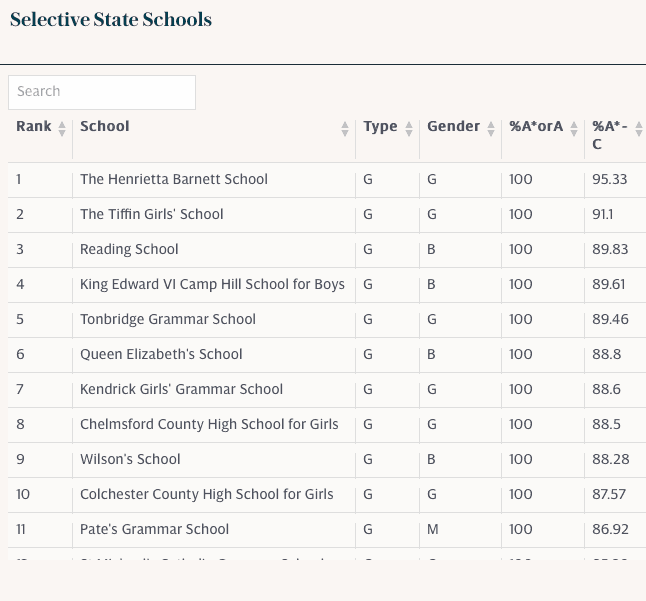GCSE Grades 2016- Grammar Schools Buck The Decline
It’s that time of year again- students across the country have received their GCSE and A-level grades. But that is as unfortunate for our under-fire education system as it must have been for the students. There has been a ‘dramatic decline’ in the proportion of C grades or above. Also, a smaller decline in the number of A and A* grades.[1] This bucks the trend of recent years, which has seen results improve year on year, a fact generally challenged by a chorus of those convinced that the exams are, for some reason, getting easier. Perhaps those people will be happier now that the results have shown a decline.
GCSE Grades 2016- Grammar Schools Buck The Decline
Each year, the Telegraph publishes results of specific schools across the country. While it is easy to craft an eye-catching headline from this latest batch of results, more interesting stories can be found within them. This is perhaps for the satisfaction of those succeeding schools and parents who want the best for their children.
While not definitive, this list is published within days of the results being handed out, giving us our first chance to do a little digging and see what trends or developments we can discern.
At a time of renewed debate regarding selective schooling- brought about by Justine Greening’s open-mindedness regarding opening new grammar schools- a quick examination of the latest GCSE statistics reveals that grammar schools do indeed add value to our education system.[2]
To understand how to analyse these statistics, we must first understand the metrics by which we measure the results. There are two yardsticks. First, the percentage of pupils who achieved five grades between A* and C; second, the percentage of GCSE’s graded was given A* or A marks. (The Telegraph have yet to correct the mislabelling of the columns in the results on their web page, which confuses the two measurements- you can find updated versions on the Independent’s website).[3]
The metric of measuring the percentage of A* and A grades given shows grammar schools ahead. Not a single state school achieved more than 68%, whereas 51 grammar schools did, with one scoring 95.3% and another 91.1%.[4] To reiterate, that means that 91-95% of GCSEs graded in these schools were given either an A or A* grade. In fact, 129 out of the 132 grammar schools which forwarded their results to the Telegraph scored 40% or more on this metric.[5]
Compared with their selective cousins, comprehensive schools lag behind. The highest score on the same metric posted by a comprehensive school is that of Dame Alice Owen’s school, which reported a relatively low 68.5%.[6] Only five state schools in total scored over 50%, and only 26 of the 182 comprehensives received more than 40%. [7]
Furthermore, comprehensives were outscored by their grammar school opponents with regards to the proportion of their pupils who achieved five A* to C grades overall. Again, 129 grammars earned over 90% in this measurement, with the lowest score achieved of 85%.[8] By comparison, 173 of the comprehensives scored lower than 90%, with only 9 scoring higher.
The key to the difference between the two lies in one fact- grammar schools are selective. Quite naturally, the schools that teach pupils they have selected based on academic merit achieve higher scores at the end of the pupils’ stay.
To illustrate this in action, the statistics include ‘partially selective’ schools, which, as their name suggests, are a sort of middle ground between regular state schools and selective grammar schools. These partially selective schools are counted as comprehensives, and three of the four highest-scoring comprehensives when judged by A* and A grades are somewhat selective.
There are, of course, exceptions. Take St. Anselm’s College as an example; while 88.9% of pupils passed had five A* to C grades overall, only 23% of the GCSEs graded were of A or A* quality. Similarly, 97.3% of pupils at Oakwood Park Grammar school received five A* to C grades, a fantastic figure in context, but only 32.3% of their marks came back as A or A*.
Thomas Telford School pushed 98% of their pupils to five A* to C grades on the comprehensive side of the divide. Clearly, a school need not be selective to be high-achieving.
Of course, the suggested reaction to this analysis is to ‘take it as you will’. It is hardly surprising that selective schools, which by nature select the highest achievers among their applicants each year, are those with the highest results. For a parent, however, seeing that 99% or more pupils received at least five A* to C grades in 70 of the 132 grammar schools whose results were published is reassuring.
It suggests that no (or very, very few) children manage to slip through the system and fail to achieve at these schools. If my children were leaving for secondary school this year, I would most certainly rest assured if I were able to send them to a school with results like these.
To argue over which is better, therefore, is to ignore the fact that the two play different parts and fulfil different roles in our children’s education. Grammar schools more often than not provide a higher level of education, and in an ideal world, it is for the best that high-achieving pupils are challenged to a greater extent than others.
Not all children can challenge themselves to the highest academic level, nor should they have to, while no child should be left behind, nor should any child be held back. This is the value that grammar schools can add to our education system; the key to unlocking this potential value is to open up grammar schools even further to children of all backgrounds.
http://www.bbc.co.uk/news/education-37175848
http://www.bbc.co.uk/news/uk-wales-37132039
https://www.theguardian.com/education/2016/aug/25/gcse-results-dramatic-decline-grades
http://www.telegraph.co.uk/education/2016/08/26/gcse-results-2016-state-school-results/
[1] https://www.theguardian.com/education/2016/aug/25/gcse-results-dramatic-decline-grades
[2] http://www.telegraph.co.uk/education/2016/08/26/gcse-results-2016-state-school-results/
[3] http://www.independent.co.uk/news/education/education-news/gcse-results-2016-best-state-schools-top-100-grades-uk-secondary-where-are-a7211931.html
[4] http://www.telegraph.co.uk/education/2016/08/26/gcse-results-2016-state-school-results/
[5] http://www.telegraph.co.uk/education/2016/08/26/gcse-results-2016-state-school-results/
[6] http://www.telegraph.co.uk/education/2016/08/26/gcse-results-2016-state-school-results/
[7] http://www.telegraph.co.uk/education/2016/08/26/gcse-results-2016-state-school-results/
[8] http://www.telegraph.co.uk/education/2016/08/26/gcse-results-2016-state-school-results/







